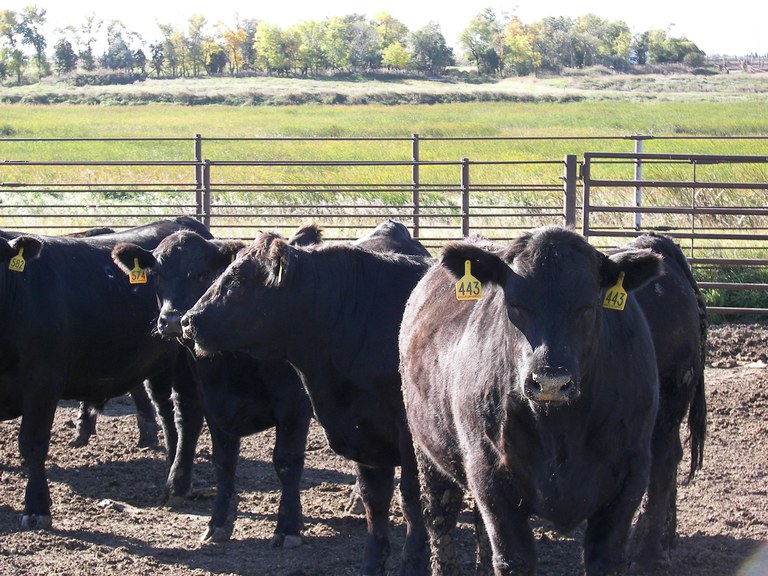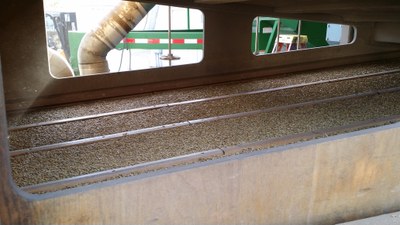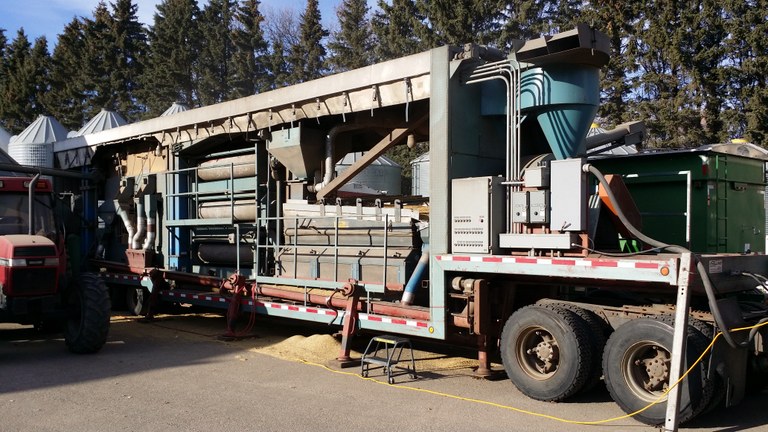2014
A Collaborative Effort to Develop an Organic Field Pea Variety
Organic agriculture poses unique challenges for the organic farmer. Some of the challenges are limited variety selection and availability of certified organic seed. Recent surveys illustrate the use of certified organic seed by certified organic farmers to be low (19-47% depending on crop type). Results also demonstrate that farmers are attempting to source more organic seed, although variety choice and availability of organic seed is a challenge. The USDA’s National Organic Policy (NOP) requires the use of organic seed when commercially available. When the NOP began the organic seed sector rarely existed and is continually growing to meet the demand of organic production. Currently there are few public and private breeding programs focusing on the development of organic seed. A basic principle in plant breeding is that you “breed and select in the environment of intended use”, and for organic agriculture that means selection and development in certified organic fields.
The CREC has a history of variety evaluation, development, and increase. The Center has worked with NDSU along with other University and private plant breeding projects to aid in this mission. The CREC has partnered with industry in a number of ways to assist in variety development. One unique partnership has been in development of a local/regional pea seed industry. We have aided in varietal development from screening experimental cultivars to increasing foundation seed.
During the past two growing seasons a new collaborative effort with field pea was formed. This time the focus was varietal development in certified organic fields. The CREC partnered with industry, Non-Governmental Organizations (NGO’s), and certified seed growers to aid in the development of an organic pea variety.
Pulse USA(PUSA), a farmer/member owned Seed Company that specializes in pulse crops along with Blaine’s Best Seeds(BBS), a double certified (state and organic) seed grower entered 10-12 experimental cultivars from private breeding programs into the CREC organic field pea variety trials (2013 & 2014). This was done to evaluate their performance as a certified organic variety for release to organic farmers. Two NGO’s were also involved in the project, the Northern Plains Sustainable Ag’s Farm Breeding Club (FBC), whose members assist in the development of organic seed through research and education, and the Foundation for Agricultural and Rural Resources Management and Sustainability (FARRMS) a non-profit educational organization that provided the funds for variety testing.
The ultimate goal of the project once the evaluation of experimental cultivars is complete will be to select the best lines adapted to an organic environment then secure seed and rights to grow and sell seed. The seed grower will then grow the varieties in a certified field making organic pea seed available to meet the growing demands of organic agriculture.
Both growing seasons were favorable for the performance and evaluation of the organic field pea variety trials. Click on the links to view the data from each trial year.
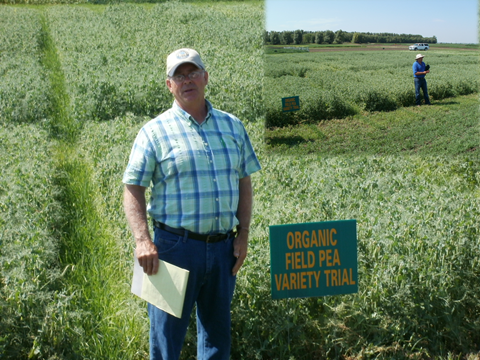
Blaine Schmaltz,(BBS) left, and Byron Lannoye, (PUSA) upper right, discuss organic field pea variety
selection at CREC annual field days in 2014 (left) & 2013(right).
A big thank you goes to all groups involved in this project, the combined effort made it possible to address the need, along with FARRMS for providing the funding through the Grants to Grow Seed Initiative program.
To close, a saying used by the early field pea seed growers and distributers as a means of industry promotion is still worth repeating. It simply states “Give peas a chance”.
Happy New Year to all!
Steve Zwinger
Agronomy Research Specialist
Impact of Corn Plant Establishment on Grain Yield
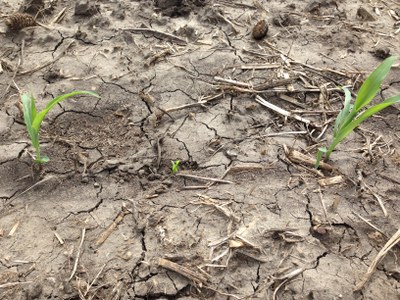 North Dakota State University conducted a statewide study in 2013-14 to evaluate the impact of corn plant establishment on grain yield. The study’s basic objective was to measure the yield response of late-emerging plants, plant doubles and plant skips compared to normally emerged and evenly spaced plants. This report will summarize highlights of the study conducted in Eddy, Foster and Wells counties using data from seven fields.
North Dakota State University conducted a statewide study in 2013-14 to evaluate the impact of corn plant establishment on grain yield. The study’s basic objective was to measure the yield response of late-emerging plants, plant doubles and plant skips compared to normally emerged and evenly spaced plants. This report will summarize highlights of the study conducted in Eddy, Foster and Wells counties using data from seven fields.
Commercial corn fields were selected for the study. Three plots were located within each field at or soon after planting, and consisted of 12 or 16 rows with a length of 30 feet. Data collected soon after planting included soil type, tillage system, soil moisture, type of corn planter, planter speed, row spacing, corn hybrid, planting date, planting depth, starter fertilizer and previous crop residue levels. Plant populations were measured at emergence and about 7 and 14 days after the initial emergence date. Also, plants emerging after general field emergence time were identified, as well as plant skips (plants with distance greater than 12 inches of one another within row) and plant doubles (plants within 2 inches of one another). In addition, corn rows were identified that had most and second-most, and least and second-least plant variability based on timing of plant emergence. At corn maturity, ears were hand-harvested from selected plants and rows to determine grain yield, moisture and test weight.
Table 1 summarizes early season data among the seven corn fields. Planting dates ranged from May 14 to June 2. Planting rate ranged from 30,000 to 36,000 seeds/A with a study average of 32,400 seeds/A. Plant population about a month after planting ranged from 26,100 to 33,700 plants/A with an average of 29,100 plants/A. Early season plant stand ranged from 4 to 25% less and averaged 10% less compared to the seed planting rate.
Table 2 summarizes harvest data among the seven corn fields. Each field contained plants that emerged about 1 to 3 weeks after general plant emergence. Ear weight of these late-emerging plants was 7 to 100% less and averaged 45% less compared to ear weight of timely emerged plants. Ear weight from wide-spaced plants within rows was 4% greater than uniformly spaced plants. Plant doubles within rows had ear weight 3 to 56% less and averaged 19% less than ear weight of uniformly spaced plants. The study confirms that using planting techniques that optimize timely field plant emergence is important to maintain yield potential. Uniform plant spacing within rows also aids in maintaining yield potential but variability of plant spacing has less negative impact on yield compared to late-emerging plants.
Greg Endres
Area Specialist, Cropping Systems
Tim Becker
Eddy County Extension Agent
Joel Lemer
Foster County Extension Agent
Lindsay Maddock
Wells County Extension Agent
Organic Research at the CREC
North Dakota has been a leader in the nation in terms of total USDA certified organic acres when compared to other states. Recent years have seen our ranking decline somewhat, although we still continue to have a place in total production acres. The Carrington Research Extension Center’s mission includes addressing the needs of many types of farms and farming systems. Research trials conducted in a certified organic environment is just another method of delivering information to serve the needs for this group of farmers along with building a long term database of information related to this farming method.
The Center has been conducting research in certified organic environments for the past 15 growing seasons both on-farm (research center) and off-farm (farmers’ fields). Research sites off-farm have been located near the North Dakota communities of Cathay, Robinson, Tappen, Dawson, Fessenden, Rugby, and LaMoure. The Center’s certified organic land has been approved by the USDA for 7 years, with the last restricted product applied in the summer of 2004. Recently, the center has converted an additional 12 acres of land to meet the needs of this constituency. This new plot ground will be certified organic in 2016.
The majority of the research conducted has been to provide organic crop and variety performance data for wheat, oats, barley, durum, flax, field pea, dry bean, soybean, cowpea, emmer, einkorn, spelt, potato, buckwheat, rye, and cover crops. Other areas of research have included trials related to various production practices or management such as: seeding rate and date, cover crop management, compost tea, seed source and increase, no-till, and rotation trials using animal manures and cover crops.
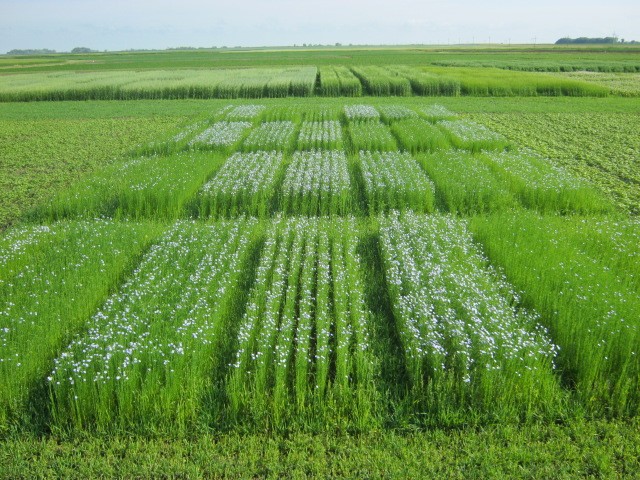
Organic flax variety trial, July 11, 2014
Management practices of the organic plots have focused mainly on crop rotation and the use of green manure cover crops to supply crop nutrient needs. To date, animal manure, with the exception of rotational trials, has not been used. Future plans are to incorporate manure applications as a method of supplying crop nutrients. With additional land the CREC will be able to expand its effort in organic research. The added land base will also allow collaboration with other NDSU scientists and Universities who are interested in conducting research in this environment.
Current variety trial information from the CREC organic plots is available on the NDSU variety trial site or the CREC variety trial site (www.ag.ndsu.edu/varietytrials/carrington-rec/2014-trial-results) which includes data across multiple years and locations. Trial results are also available by hardcopy in the CREC annual reports or by request.
Steve Zwinger
Agronomy Research Specialist
Wheat Grain Yield and Protein Response to N from Manure on an Upland Field in Hurdsfield, ND
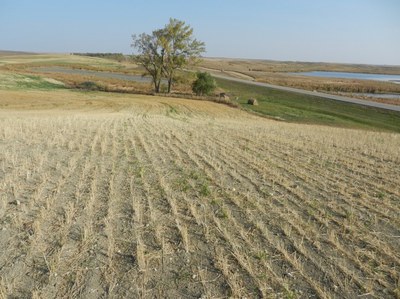
Soil characteristics:
Low soil organic matter and low fertility (N = 13.3, K = 422, S = 29.3, Zn = 0.7 lbs/ac, OM = 2.5%, and pH = 8.3).
Treatments:
Manure and urea were applied, including a check plot (0 lbs N) at 45, 90, and 135 lbs N. Urea plots received 20 lbs of P (44 lbs P2O5), 10 lbs of S, and 1 lb of Zn.
Results and Observations:
- Grain yields were higher from manure application than from urea. The treatments indicate that application of manure probably improved soil condition, which had a strong influence on grain yields.
- When 45 lbs. N was applied as manure, yields and grain protein were not significantly different from the 90 and 135 lbs. manure N rates.
- Economic analysis of the cost of manure application versus urea application showed it was better to apply N as urea than using manure (NDSU Carrington Research Extension Center Report of Agricultural Research to be published in January 2015).
- The results indicated than profitability from urea N was mainly due to higher premiums from grain protein. Because the cost of applying 90 and 135 lbs. N as manure was higher than applying 45 lbs. N, but insignificant difference in protein content, it was more economical to apply manure at 45 lbs N. The likely reason for low protein compared to urea was availability, and that some of the manure N was immobilized at higher rates.
- It is therefore likely that application of readily available N as a supplement to manure application would not only boost yields from improved soil physical and chemical properties, but would also enhance N uptake and protein content in the grain.
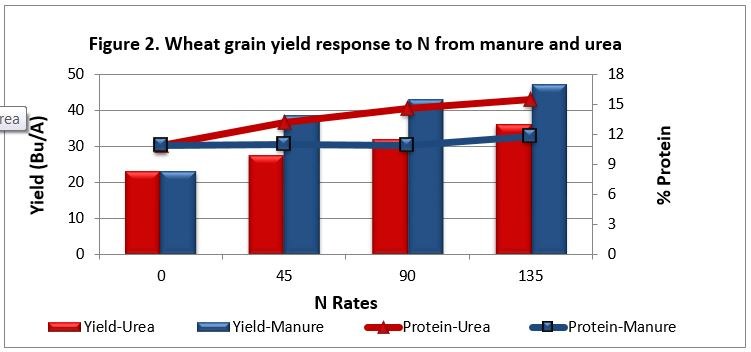
Jasper M. Teboh
Soil Scientist
New Animal Scientist Joins the CREC
Greetings from Carrington! My name is Anna Taylor and I am the new Animal Scientist at the Carrington Research Extension Center (CREC). I’ve returned to North Dakota after spending several years at South Dakota State University (SDSU) for my education. I am originally from Mandan, where I grew up on a hobby farm. I pursued an animal science degree at SDSU thinking I wanted to be a veterinarian. During my undergraduate studies I was able to be involved with beef research, which ultimately became a turning point in my career path. I have a broad scope of experiences from my time at SDSU including reproductive physiology, immunology, meat science and ruminant nutrition. My most recent research focused on fetal programming, feedlot nutrition and management, and meat quality.
At the CREC Livestock Unit, I look forward to exploring numerous topics including:
- Utilizing cover crops and crop residue to reduce feed costs
- Optimizing backgrounding management techniques
- Evaluating North Dakota agriculture by-products in cattle diets as they impact cattle performance, logistics, and economics
- Impacts of facilities design on beef cattle performance
- The value of being a farmer-feeder
- And the many collaborations at the CREC and at NDSU
I am excited about the opportunities the CREC has to address the needs of crop and livestock producers in North Dakota. I look forward to meeting you down the road!
Anna Taylor
Animal Scientist
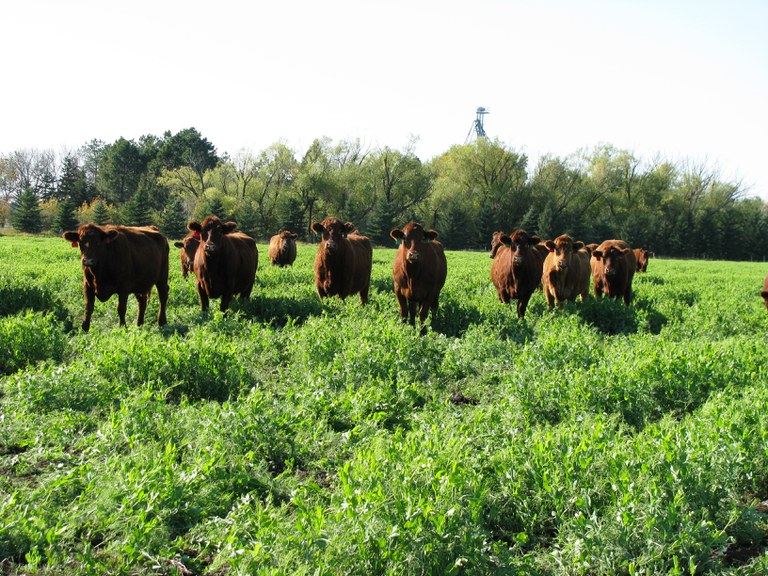
Soybean Population and Planting Date Effects
Soybeans are known to compensate well for stand loss in the field. This is one reason why there is such a wide range of plant populations that are considered acceptable, and why there are differing views about when to replant a soybean field after stand loss has occurred. Many studies have been conducted at NDSU recently to quantify planting date or plant population effects on yield. In 2014, a study was conducted to consider evaluate both factors. The goal of this study was not to justify reduced populations as a whole, but provide comparisons to make more informed decisions regarding replanting scenarios.
Three planting dates were used (May 23, June 5 and June 23) and five target populations, ranging from 80,000 to 200,000, were planted at each date. Soybean compensation was measured by branch number and seed number per plant. Across the planting dates, the branch number increased by 3-4 per plant as the plant population approached 80,000 and the seeds per plant doubled over that same range. This resulted in a 57 (at 200,000) compared to 41 (at 80,000) bu/a yield. In 2014 the yield loss by waiting until June 5 was 64% compared to the May 23 date. The difference between June 5 and June 23 was less. Even though there were two weeks between each planting date, soybean maturity was only 6 days different at each planting date as well.
The real power of the study though is the ability to compare the planting date and population together. Here is a short chart to highlight the yield differences noted between the first two planting dates.
This growing season could be considered a bit atypical (as usual). You’ll note that the lowest population in the first planting date was roughly the same as the best population at the next planting date. I believe this result was due to the very warm weather that occurred at the end of May that the two later planting dates missed during the fairly cool summer conditions.
Partial sponsorship for this study was from the North Dakota Soybean Council. More work will continue next year to develop more long-term patterns in soybean yield.
Mike Ostlie
Agronomist
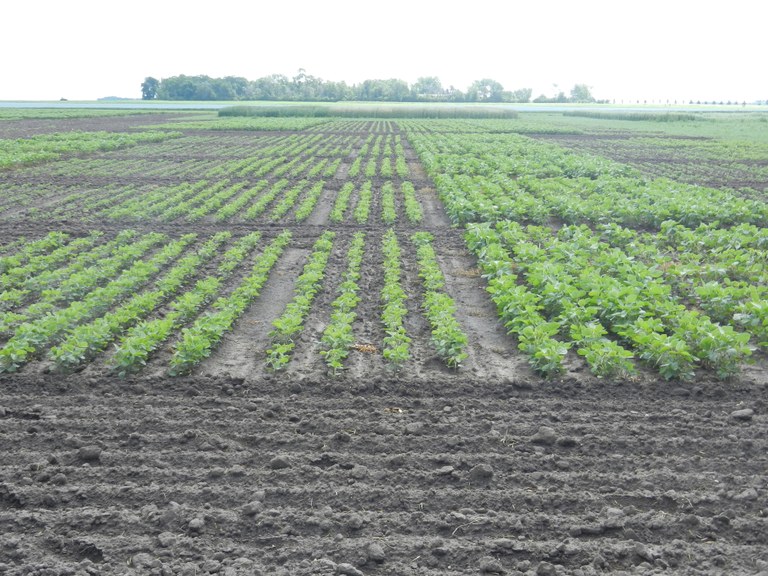
2014 Irrigation Update
The last two years the Carrington Research Extension Center has experienced each end of the spectrum in regards to precipitation influences on crop growth. In 2013, we were extremely dry and received very little rain throughout the growing season which caused significant gains in our irrigated variety trials, most significantly on corn and soybeans. This year however, consistent rainfall throughout the growing season helped minimize moisture stress on all of our crops and we have not experienced any significant differences in our irrigated yields compared to our dryland. Irrigation management remains a top research priority here at the CREC and we continue to work to identify better methods for properly managing our water use through irrigation.
Table 1. Rainfall Received at the CREC Table 2. Irrigation Applied at the CREC

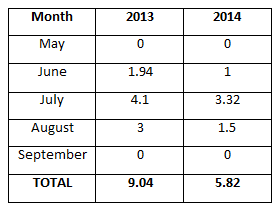
Look for more information on irrigation management and influences on various crop inputs in the upcoming 2014 Annual Report. Contact Justin Berg at 701-652-2951 or justin.t.berg@ndsu.edu for more information on irrigation management here at the CREC.
Overview of CREC 2014 Soybean Variety Performance Trials
2014 soybean variety trial data are now available from the Carrington Research Extension Center (CREC) to provide soybean growers with information to assist with choosing varieties for production in 2015.
An overview of variety trials:
- Carrington dryland Roundup Ready (RR) trial tested 71 commercial varieties with maturity groups ranging from 00.8 to 0.8. Average days from planting (May 23) to maturity was 119 (September 19) and the trial was harvested on October 3. Seed yield averaged 61.3 bu/A with a range of 47.0 to 70.2 bu/A among varieties. Test weight averaged 57.0 lb/bu and the average number of seeds/lb was 2866 with a range of 2285 to 3356 seeds/lb. Seed oil and protein data are pending.
- Other soybean variety trials conducted at Carrington and yield average (bu/A): irrigated RR - 50.2; dryland conventional - 46.5; irrigated conventional – 46.9.
- Off-station trials conducted by the CREC and yield average (bu/A): Dazey RR – 55.7; Dazey conventional – 48.1; LaMoure RR – 68.1; Oakes irrigated RR – 67.1; and Wishek RR – 58.2.
Data can be found at the following website: www.ag.ndsu.edu/varietytrials/carrington-rec/2014-trial-results.
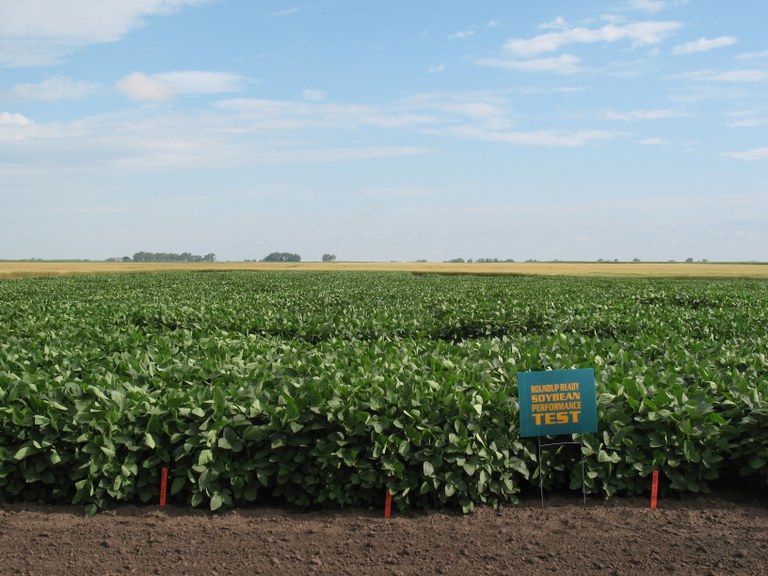
Greg Endres
Area Specialist, Cropping Systems
Conditioning Seed
With all of our Seedstocks crops off the field, our attention is now focused on conditioning seed for planting next spring.
The NDSU Agronomy Seed Farm in Casselton led the process to have the mobile mill designed and constructed on behalf of the NDSU Foundation Seedstocks program. The mobile mill has three different styles of cleaners contained in one 53-foot, curtain-side trailer. We use this mobile mill, capable of cleaning 300 bushels per hour, during the mid to late weeks each fall to condition 50,000 - 60,000 bushels of spring wheat, barley, durum, buckwheat, and soybeans for the coming planting season.
(CREC’s in-house mill, constructed in the early 1962, cleans about 30 bushels an hour, and is used to clean field peas before the mobile mill arrives. Flax is cleaned in-house, too, because the mobile mill doesn’t have special screens required for the flat, oval shape of flaxseed. Typically the in-house mill runs until late March or early April shortly before spring planting.)
When the mobile mill arrives at CREC, it is inspected to make certain everything is in working order. Set up includes positioning six outriggers to stabilize and level the trailer. A semi-tractor pulls the unit on the highway, but a separate diesel generator powers all of the conveyors, augers, pulleys, fans, brushes, and electrical switches and gauges required to operate the mill.
Seed grains are handled as carefully and as gently as possible to preserve the vital germ from which the sprout will grow. Instead of using augers which could crush kernels, conveyors are used to carry the seed, and drop distances are minimized whenever possible.
Sifter Sieve
Conveyors lift bin-run grain into the back of mill, where seed enters the top the first cleaner, an air screen with large, flat screen-tables (sieves) with round or slotted holes. The top sieve, called a ‘scalper’ sieve, allows grain to pass through round holes, while straw and other large impurities are pulled out by a steady air flow. Each of the lower ‘sifter’ sieves have elongated slots rather than round holes, so broken kernels and small weed seeds fall through the slots and collect at the bottom of this cleaner. Sieves are set at an incline, and as the sieves shake and bounce, the clean grain gradually bounces/falls/moves to a conveyor at one end. To keep sieves clear of debris and operating at peak efficiency, brushes constantly slide back and forth across the bottom side of each screen. Screenings such as broken, small, or undeveloped kernels are augered to a waiting truck, while the partially-cleaned seed moves to the next cleaner, an indent cylinder machine, via another conveyor.
Indent Cylinder
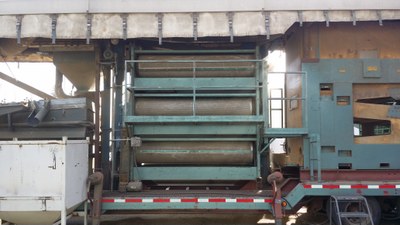 The indent cylinder cleaner features a “six pack” of drums, two stacks of three inclined horizontal rotating cylindrical screens. (The duplicate stacks facilitate cleaning twice the volume.) The inside of each drum is covered with tiny indents, or pockets. Each series of indent cylinder machines is designed to separate seed by length, using a combination of pocket size, rotation speed (which cause a centrifugal force), friction and gravity. By using screens with a specific pocket size, same-size particles nestle into the pockets and are lifted as the drum rotates. Friction and centrifugal force hold the particles in place, but as the cylinder turns, particles are lifted to a point where gravity takes over and kernels fall onto a collection trough where an internal conveyor pan/shelf catches the grain as it tumbles from the upper inside edge of the drum. Differing sizes of drums collect different lengths of seed, with rotation speed dictating the point that the seed falls to the pan. Desirable seed is captured either by collection within the drum, or by capturing undesirable items with the drum and allowing good seed to pass through. Again, screenings are augered out and cleaner(er) grain is conveyed to the next phase.
The indent cylinder cleaner features a “six pack” of drums, two stacks of three inclined horizontal rotating cylindrical screens. (The duplicate stacks facilitate cleaning twice the volume.) The inside of each drum is covered with tiny indents, or pockets. Each series of indent cylinder machines is designed to separate seed by length, using a combination of pocket size, rotation speed (which cause a centrifugal force), friction and gravity. By using screens with a specific pocket size, same-size particles nestle into the pockets and are lifted as the drum rotates. Friction and centrifugal force hold the particles in place, but as the cylinder turns, particles are lifted to a point where gravity takes over and kernels fall onto a collection trough where an internal conveyor pan/shelf catches the grain as it tumbles from the upper inside edge of the drum. Differing sizes of drums collect different lengths of seed, with rotation speed dictating the point that the seed falls to the pan. Desirable seed is captured either by collection within the drum, or by capturing undesirable items with the drum and allowing good seed to pass through. Again, screenings are augered out and cleaner(er) grain is conveyed to the next phase.
The final cleaner on the mobile mill is a gravity table, used to separate heavier seed from identically-sized seed of lesser weight. Here, flat inclined screens shake as a fan blows from underneath the screen. Heavier particles are lifted a shorter distance and travel uphill as the lighter materials float higher and longer and fall downstream, where they are separated off.
Gravity Table
While screen and slot size determine the type and size of seed cleaned, the one constant, though the operation of all of these cleaners, is fine adjustment. A few pounds of air pressure, a few RPM’s (revolutions per minute) on a drum, a few degrees of inclination, or a few millimeters difference in pocket size, all make a tremendous difference as to what is saved or scrapped.
Ultimately, barley screenings are fed to cattle involved in research projects at the CREC Livestock Unit. Other screenings are sold on the open market at local elevators.
Clean seed is stored in hopper bins or totes or bagged for storage on pallets, waiting for spring planting.
Dave Copenhaver
Foundation Seedstocks Research Spec.
2014 North Dakota Beef Research Report & NDAU Update
2014 North Dakota Beef Research Report 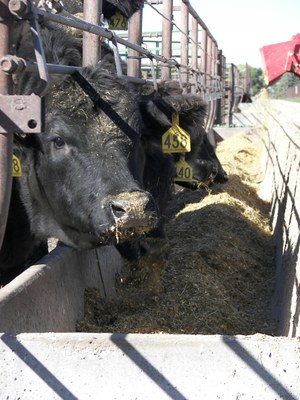
The 2014 North Dakota Beef Research Report is hot off the presses. The beef research programs at the NDSU main campus in Fargo and the Research Extension Centers across North Dakota are dedicated to serving the producers and stakeholders in North Dakota by developing knowledge and technology to improve the management, efficiency and production of high-quality cattle and beef using sustainable and safe approaches. This report includes a broad range of research from on-campus departments, schools and centers, as well as Research Extension Centers across the state, and provides producers and stakeholders with one document that contains all beef related research conducted at NDSU each year. Hard Copies are available at the NDSU Carrington Research Extension Center or click the following link to access this most recent as well as past Beef Research Reports.
http://www.ag.ndsu.edu/cattledocs/research-reports
2014 North Dakota Angus University Feed-Out Project
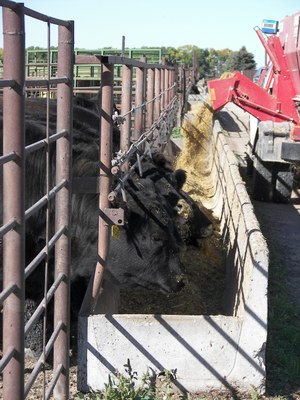 The 2014 North Dakota Angus University (NDAU) Feed-Out project came to a close, with the last group of calves marketing last week. This year 164 head of Angus steers, consigned by North Dakota producers, participated in the third annual feed-out program at the NDSU Carrington Research Extension Center. The Angus University cattle were enrolled in a feeding trial evaluating three corn tempering dietary treatments compared to the control diet of dry-rolled corn. Tempered corn is corn that is re-hydrated to be around 20% moisture (80% dry matter), prior to rolling through a roller mill. The three corn tempering treatments were corn tempered with water; corn tempered with water and a surfactant, or corn tempered with water and condensed distiller’s solubles. The tempering process is often used with barley in barley-based finishing diets. The objective was to evaluate if the tempering process could be used in corn based diets to improve animal performance, carcass characteristics, and overall feeding efficiency.
The 2014 North Dakota Angus University (NDAU) Feed-Out project came to a close, with the last group of calves marketing last week. This year 164 head of Angus steers, consigned by North Dakota producers, participated in the third annual feed-out program at the NDSU Carrington Research Extension Center. The Angus University cattle were enrolled in a feeding trial evaluating three corn tempering dietary treatments compared to the control diet of dry-rolled corn. Tempered corn is corn that is re-hydrated to be around 20% moisture (80% dry matter), prior to rolling through a roller mill. The three corn tempering treatments were corn tempered with water; corn tempered with water and a surfactant, or corn tempered with water and condensed distiller’s solubles. The tempering process is often used with barley in barley-based finishing diets. The objective was to evaluate if the tempering process could be used in corn based diets to improve animal performance, carcass characteristics, and overall feeding efficiency.
Cattle started the trial in June 2014 weighing an average of 896 lbs. After approximately 114 days on feed the steers were marketed at an average finish weight of 1387 lbs. The overall average daily gain for the group was 4.45 lbs. per day. Looking at the preliminary animal performance data (table 1) the three tempered corn treatments had numerically greater average daily gains compared to the dry rolled corn treatment diet (4.5 lbs./day vs 4.3 lbs./day). Over the next few months we will further analyze the full data set to determine if tempered corn is a viable feedlot management practice. More details of the trial will be presented at the North Dakota Angus Association annual meeting in November and published in the 2015 North Dakota Beef Research Report.
Table 1. 2014 NDAU Corn Tempering Research Project Preliminary Steer Performance data.
We would like to express our thanks to the producers who consigned cattle and to the North Dakota Angus Association for partnering with the NDSU Carrington Research Extension Center for the third annual NDAU. Also, thank you to the North Dakota Corn Utilization Council for supporting this corn tempering research.
Chanda Engel
Livestock Research Specialist
